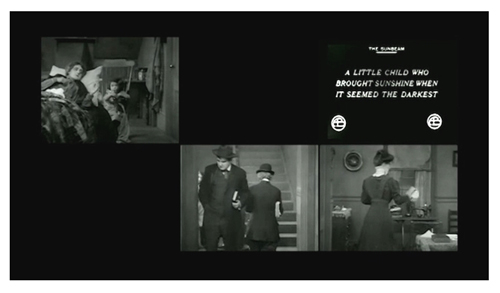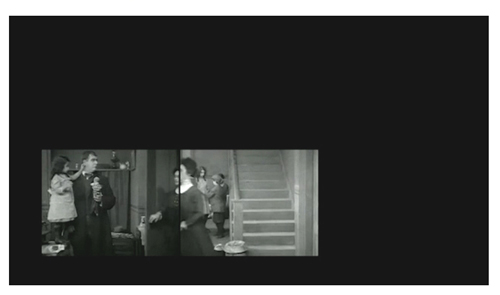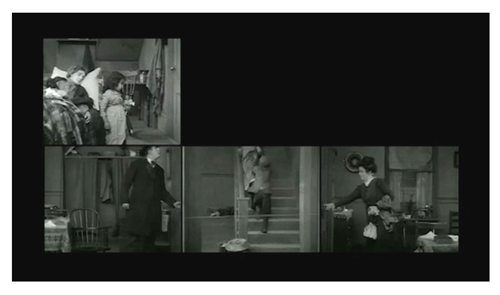A variation on a sunbeam: Exploring a Griffith Biograph film
Monday | September 5, 2011 open printable version
open printable version
Kristin here:
On April 21 a young Spanish film student uploaded his remarkable little film, Variation: The Sunbeam, David W. Griffith, 1912 onto Vimeo. There it languished, like so many contributions to the internet, good and bad. In the first four months of its presence on the site, it attracted 17 views.
Then, on August 17, Variation was viewed twice and earned its first “Like.” (One has to be a member of Vimeo to Like a film, so one cannot assume that none of its viewers to that point had enjoyed it.) That first Like, and perhaps both views were by Kevin B. Lee, best known for his many video essays on classic films. (See here for an index; I contributed the commentary for the La roue entry.) Over the next week and a half there were five additional views, four on August 28. I suspect some or all of these last ones were repeat visits by Kevin, since on August 31 he was the first to post an essay on Variation: The Sunbeam, David W. Griffith, 1912 (hereafter Variation), along with some information on its maker, Aitor Gametxo.
The immediate result was a flurry though not a stampede of views: 33 on August 31, along with a second Like; and 15 on September 1, with a third Like. One of those views and the third Like were mine. On September 2, there were 12 views, dwindling to 2 on September 3 and 1 on September 4.
(Among the viewers after the Fandor entry was Evan Davis, University of Wisconsin-Madison film-studies alumnus, who read Lee’s blog, watched the film, and passed the links along to us. Thanks, Evan!)
It’s a pity that more attention has not been paid to this charming, clever, and informative film. Not only would people enjoy it, but it could easily be used as a tool for those teaching, or indeed researching silent cinema. So here’s my bid to help it go viral.
Variation is a found-footage film based on Griffith’s American Biograph one-reeler The Sunbeam, made in December, 1911, and released on March 18, 1912. It is not among the most famous of the nearly 500 one- and two-reelers Griffith directed at AB between 1908 and 1913, but it’s better known than most. In the opening, a sick mother dies, and her little girl, thinking her mother is asleep, goes out into the hallways of their working-class apartment building. She tries to find someone to play with, but everyone rebuffs her until she manages to charm two lonely people, a bachelor and spinster, who live opposite each other on the floor below the child’s home.
Aitor noticed three key things about the film. First, the action takes place in a very limited space, with the three apartments and hallway all close to each other. Second, the doorways through which the characters pass between these rooms are on the edges of the screen, so that when they exit through the doorway in one shot and after the cut enter the space on the other side of the doorway, there is often a sort of elusive match on action formed (what I termed a “frame cut” in The Classical Hollywood Cinema, p. 205 and figures 16.36 and 37). Third, and perhaps most importantly, Griffith was intercutting actions that were happening simultaneously, so that at many of the cuts, he jumped from the end of an action in one space back in time to catch up with what had been happening in another space. At times he would jump back twice if simultaneous actions were happening in three spaces.
Aitor has taken the individual shots and redone them, putting them into a grid of six small frames, three on the bottom and three at the top. Scenes in the child’s upstairs apartment are shown only in the upper left, the top of the stairway in the upper center, and the two apartments on the ground floor at the sides, with the hallway and bottom of the stairs between them. (See above.) These are roughly the actual positions these spaces occupy in relation to each other in the building represented in the film. The shots run in their true temporal relations, so that there is no jumping back.
I suggest that before reading further, you watch The Sunbeam, especially if you have never seen it before. It would be impossible, I think, to entirely follow the story just from seeing Variation. The shots are so reduced in size to fit into the grid that small but important gestures and details get lost. Here is the original film, from YouTube.
With Aitor’s kind permission, we present his take on Griffith’s one-reeler. (The Sunbeam runs about 15 minutes, but due to the simultaneous presentation of many shots, Variation is only about 10 minutes.) Click on the “Vimeo” logo in the lower right corner for a larger image:
A fascinating film, isn’t it? I think many viewers would reach the end of Variation and wish that the same sort of presentation could be created for other films–at least, early ones that are short enough to make such rearrangement viable. Kevin Lee is enthusiastic about the idea: “Imagine this multi-dimensional, real-time approach being applied to footage from other films, as a way of not just mapping out scenes in a movie, but also gaining insight into filmmaking technique.” It might be possible, but the six-rectangle grid used here would not work for very many films. Aitor has chosen the ideal film for such an approach. Not only are there a limited number of significant characters, but they also live in the same building, with three rooms and a hallway, all viewed from the same direction, making them fit perfectly into a “doll-house” style scene.
Had Griffith not routinely shot directly toward the back wall in all his sets, placing the shots directly side by side across the grid would not work, at least not so neatly. Many other directors of this era were exploring shooting into corners and having doorways for entrances and exits centered at the rear. Perhaps filmmakers like Aitor could still place different shots side by side, but the actors’ movements from one space to another would not be so smooth. One of the attractions of Variation is that those movements are smooth, and as a result the action plays as if it were part of a continuous, “real” film.
Even other Griffith films shot in the style of The Sunbeam would be far more difficult to lay out on a similar grid. Longer rows of more rectangles would need to be added, or the upper row would have to represent actions taking place at a distance and the lower one actions taking place within a building. (I’m thinking here of something like The Lonely Villa, where action in a series of contiguous rooms is intercut with the husband’s race from a distant locale back to his house.) The placement of the bachelor’s room opposite the spinster’s, on either side of the hallway through which all of the minor characters pass, is crucial to Aitor’s project. A complex film with many characters and locales might create a grid with rectangles too small to be grasped by the viewers. Ways of indicating techniques like flashbacks would have to be devised. And of course, not all films contain simultaneous action.
Variation has some technical disadvantages. The titles appear in the upper right corner of the screen, since no locale opposite the child’s apartment is ever shown. The titles are small and difficult to read, and since they pop up simultaneously with the action, it’s almost impossible to read them anyway. One cannot tell where the titles originally came in the flow of shots, though one can always check the original film. Another problem is the cropping of the images on all four sides. The DVD copies are somewhat cropped, and more of the image is eliminated in the Variation frames; the action of the little heroine hiding a hairpiece in the spinster’s home, an important motivation for later action, can barely be grasped because it is so small a detail and happens at the very bottom of the frame; in the DVDs it can be clearly seen.
The Griffith Project and our knowledge of his techniques
I do not intend by any means to diminish what Aitor has accomplished when I say that the three main techniques he works from have been known to Griffith scholars for years. Variation offers a new way of examining and explaining those techniques.
Griffith has, of course, been one of the most closely studied filmmakers in history. A vast summary of and contribution to the research on Griffith was recently compiled by “Il Giornate del Cinema Muto” film festival in Pordenone, Italy. From 1997 to 2008, the festival mounted a nearly complete retrospective of Griffith’s work, hampered only by those films which still exist only as negatives or in other forms that could not be projected. A team of experts divided up the work and wrote extensive program notes for every single film Griffith made, whether it was shown at the festival or not. The notes, some more general essays, and Griffith’s writings were edited into twelve volumes jointly published by the festival and the British Film Institute (1999-2008). I had the privilege of contributing notes to most of the volumes, and although I cannot claim to know Griffith’s entire œuvre intimately, I got to know the films assigned to me quite well and learned a great deal about his methods.
The program notes for The Sunbeam were written by Griffith specialist Russell Merritt (Volume 5, 2001). As these excerpts from his description of the film’s setting indicate, the doll-house arrangement of the sets in The Sunbeam were distinctive, but not atypical of Griffith’s approach:
This was the second of Griffith’s three December tenement films (falling between The Transformation of Mike and The String of Pearls); spatially it is his simplest. Griffith uses only five setups (fewer than half what he works with in The Transformation of Mike and The String of Pearls.), but far from feeling cramped or monotonous, the three rooms and two hallways spaces seem perfectly designed for the playful romps, the practical jokes, and the unfolding of the gentle love story.
By 1911, the Griffith apartment set had developed a personality of its own, or more precisely, had become both distinctive and flexible enough to accommodate a broad range of narratives. Griffith’s planimetric style, with the camera always aimed straight on into the back wall with at least one side of the room aligned to the margin of the frame, had become as much a Biograph signature as the last-minute rescue, the fade-out, parallel editing, and the stock company of actors [….] In The Sunbeam, the familiar hallway and one-room apartments turn into something resembling a row of a child’s wooden blocks or the rooms in a child’s dollhouse, albeit with a dead mother in the garret. In each space, whether the hallway, the spinster’s apartment or the bachelor’s one-room across the hall, there is something to play with or play upon. The prank with the string stretched across the hallway literally links the two apartments and provides the perfect center of a the film–a gag that depends upon the mirror symmetries of the rooms and the tug-of-war actions of the two incipient sweethearts. (p. 196)
For the prank with the stretched string made symmetrical spatially as well as temporally, see below.
Ben Brewster and Lea Jacobs’ book Theatre to Film (1997) points out that cutting among multiple adjacent interior rooms was typical of Griffith’s work in this period: “By early [1911] a film like Three Sisters has a climactic sequence of 28 shots alternating between three set-ups–long-shot views of three rooms, a kitchen, a hall, and a bedroom, which movements from room to room that coincide with cuts establish as side by side.” (p. 189) My own notes for The Griffith Project volumes discuss adjacent sets and room-to-room movements using frame cuts. (See the end of this entry for a list.)
Griffith’s use of editing to convey simultaneous events, as well as to portray thoughts and flashbacks has been extensively discussed in the literature on the director.
What is remarkable is that a 22-year-old film student has noticed these devices and found a simple, elegant method to demonstrate what we already knew, but with greater precision and vividness than could be done with prose analysis. To experts, that is what should make Aitor’s film so appealing.
For example, the precision of Griffith’s matches on action at the frame cuts is illustrated time and again in Variation:
Were it not for the fact that Griffith’s camera is closer to the action in the smaller hallway set than it is in the two outer rooms, the spinster’s move through the door would almost appear to be a single smooth glide. Unless one freezes the frame, as I have done here, some of these movements look uncannily continuous.
For those teaching or reading Film Art: An Introduction, Variation also provides a clear example of story time versus plot time. Griffith’s The Sunbeam presents us plot time, with its jumps backward to cover all the action in multiple locales. Aitor’s film presents story action as we ordinarily would reconstruct it only in our minds. Usually we describe story action with synopses or outlines. To see it played out in real time is a rare treat.
The filmmaker
Aitor has a blog, which contains primarily many lovely still photographs taken in Spain, Ireland, and the United Kingdom. It offers, however, minimal information about him. Kevin Lee wrote to ask him for information, which is included in the Fandor entry linked above. I also emailed Aitor with some questions to further contextualize Variation, and he provided a short summary of his background and his interest in Griffith.
My name is Aitor Gametxo. I was born in Bilbao in 1989 and have been living in Lekeitio. I started the Communication and Film degree in the University of the Basque Country, but I moved to the University of Barcelona to finish it this year. I’m currently living and working in Barcelona, and I’m going to do a “Creative Documentary” masters degree this upcoming year. I really enjoy taking pictures of everyday things and places, as a way of reporting reality. I also love film, specially documentaries, found footage films and cinema-essay pieces. I honestly believe in the power films have to make us think about things. Not only because of the topic the film is about, but also about the way in which the film is made (a kind of dialectics between Bill Nichols’ expository and reflexive modes). I love watching old (and odd) films and thinking about things that are different from the purpose they were created for. (As I told Kevin) we are able to take some footage which is temporally and geographically unconnected to us and remodel, or refix, or remix… it, giving birth to another work. This is the way I see the found-footage praxis.
About this particular film, The Sunbeam, I watched it for the first time just before doing the variation. I knew other works made by Griffith, such as “Intolerance” (quoted in several film history books). But this was unknown for me, so that the first watching was crucial. While I was enjoying it, I was wondering what the place where it was shot looked like. I suddenly imagined it as a two-floor house, where the characters cross in some moments. Also the doors were essential to fix one part with another. This was the main idea where I worked on. It was great fun doing it.
The result is this variation in real-time action of the classic work where we can see how Griffith worked on. It’s like returning back to Griffith’s mind, to the first idea, as he imagined one hundred years ago (!) how The Sunbeam would look like. This is the magic of cinema.
My contributions to The Griffith Project‘s program notes for the Biograph years are these. In Volume 2, January-June 1909: Those Boys; The Fascinating Mrs. Francis; Those Awful Hats; The Cord of Life; The Brahma Diamond; Politician’s Love Story; Jones and the Lady Book Agent; His Wife’s Mother; The Golden Louis; and His Ward’s Love. In Volume 3, July-December 1909: Lines of White on a Sullen Sea; In the Watches of the Night; What’s Your Hurry?; Nursing a Viper; The Light That Came; The Restoration. In Volume 4, 1910: A Child’s Faith; The Italian Barber; His Trust; His Trust Fulfilled; The Two Paths; and Three Sisters. In Volume 5, 1911: The Lonedale Operator; The Spanish Gypsy; The Broken Cross; The Chief’s Daughter; A Knight of the Road; and Madame Rex. In Volume 6, 1912: The Unwelcome Guest; The New York Hat; My Hero; and The Burglar’s Dilemma. In Volume 7, 1913: The Hero of Little Italy; The Perfidy of Mary; and A Misunderstood Boy.
Like the other contributors, I found myself dealing with a few famous films (e.g., the wonderful Lines of White on a Sullen Sea) and others that were largely unknown. Each little cluster of titles assigned to us consisted of films that had been made sequentially, so that each of us could get an intensive look into Griffith’s work over the course of a few weeks. It proved to be a rewarding way of approaching the study of the director. The general editor for the series was Paulo Cherchi Usai, assisted by Cindi Rowell.
The Sunbeam is also available in the U.S. in two DVD sets: Image’s “D. W. Griffith: Years of Discovery: 1909-1913” and Kino’s “D. W. Griffith’s Biograph Shorts Special Edition.” (The discs can also be bought separately.)
















